TPO -> The TPOs of Turkey
The TPOs of Turkey
By Keith Morris
The Turkish Republic was founded in 1923 when Mustafa Kemal (later given the surname of Ataturk) overcame the Ottoman Sultan after a brief struggle. The birth of a new nation had begun. Over the next 5 years Turkey was propelled at great pace from the 18th century into the 20th century with Ataturk personally leading the way on many occasions. By 1928 the Western calendar and International numeric system had been introduced as well as a reformed alphabet.
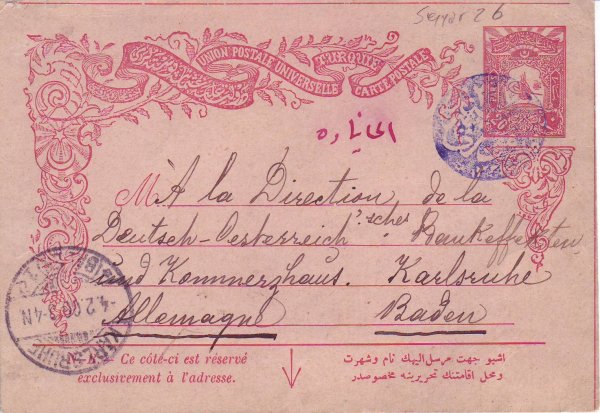
An Ottoman cover of 1906 addressed to Baden in Germany with a cancellation of 26 seyyar posta memru (26 TPO)
It was at this time that the Ottoman style TPO handstamps were replaced by something unique - TRIANGULAR handstamps. This shape had previously been used by other countries as Censor or Inspectors marks but never, before or since, had this shape been used for regular cancellation. They remained in use for nearly 50 years.
The railway system expanded considerably with the foundation of the Republic and it was not until the early 50's that roads were favoured over railways and any further development stagnated. That is not to say that Turkey is a country best suited to railways, the mountainous terrain leads to very tortuous routes and slow running times. As an example the straight line distance between Ankara and Mus is 420 miles, the distance by road 577 miles and by rail 867 miles! In addition to the railway TPOs there were some half dozen or so coastal routes as befits a country surrounded on three sides by water.
The Postmarks of Turkey

Type 1a
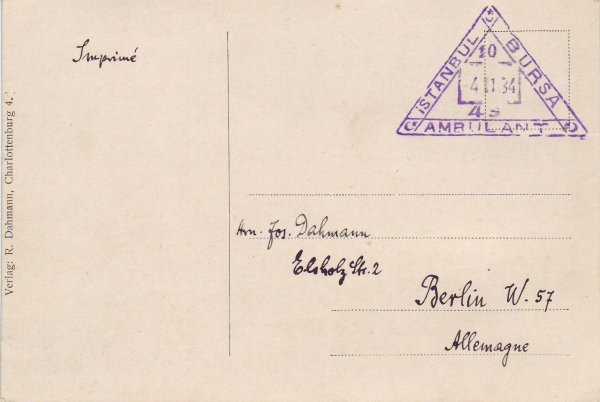
Istanbul - Bursa Ambulant, Route number 10 (later 7). This trip is by ship from Istanbul to Mudanya and thence overland to Bursa, a distance of 60 miles.
The second style of handstamp was a much more robust construction and avoided the unprotected sharp corners associated with Type 1. The star and crescent emblems were maintained but now only in the top corner. All lettering was in the "italic" style and the title "AMBULANT" replaced by the Turkish word "SEYYAR" which translates as habitually moving or portable. The route and handstamps numbers were still incorporated within the design.
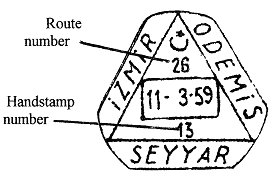
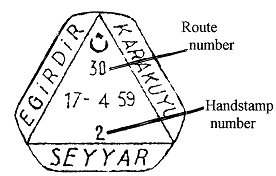 |
|
| Type 2a with date box | Type 2a without date box |
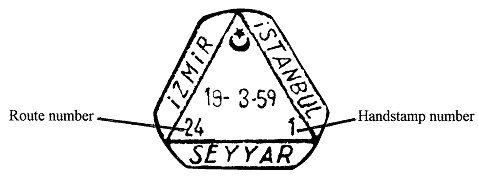
Turkish Type 2b
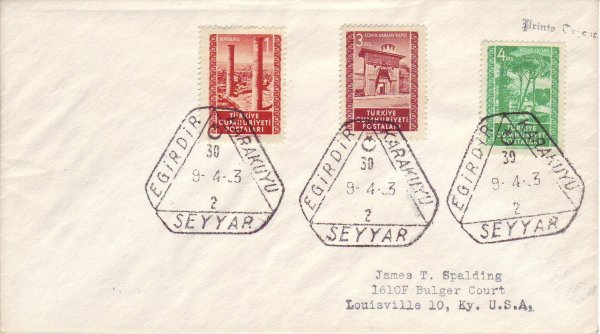
Egirdir - Karakuyu Seyyar Route number 30, distance 53 miles
The third style of handstamp introduced further rounding of the basic triangular form, the deletion of the date box and the star and crescent symbols, and with the handstamp number shown in both bottom corners.
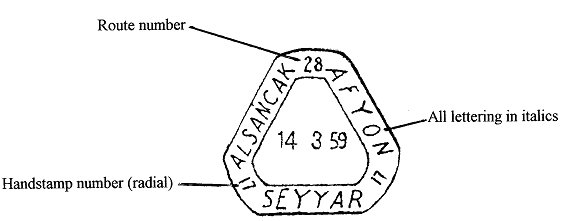
Turkish Seyyar Type 3a
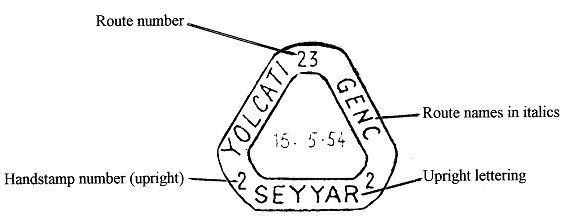
Turkish Seyyar Type 3b
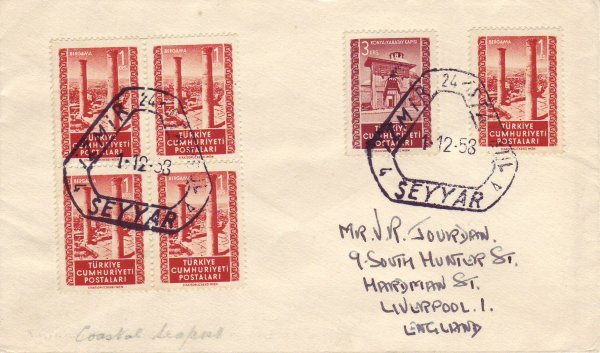
Izmir - Istanbul Seyyar, Route number 24, distance 260 miles, all by ship.
This style of handstamp, the fourth, is identical to the previous set except that the somewhat archaic word SEYYAR is replaced by the more modern Turkish word GEZICI which derives from the verb "gezmek", to travel.
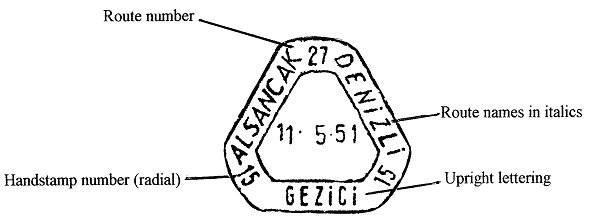
Turkish GEZICI Type 4a
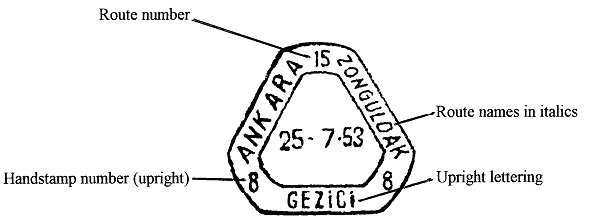
Turkish GEZICI Type 4b
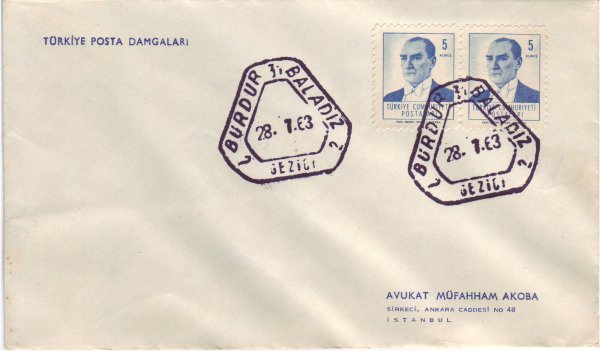
Burdur - Baladiz Gezici, route number 31, distance 16 miles. Note that Baladiz has been renamed Gumusgun.
The fifth and penultimate style of handstamp avoids the use of italic lettering and has the handstamp number positioned in the bottom corners and the route number, if shown, in the top corner.
Only one example of type 5b is known and this should be regarded as an error on the part of the die maker. Not only are the route and handstamp numbers transposed and the route number inverted but the word "SEYYAR" makes a further appearance.
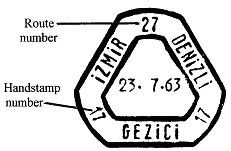
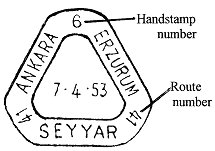 |
|
| Type 5a - Gezici | Type 5b - Sayyar |
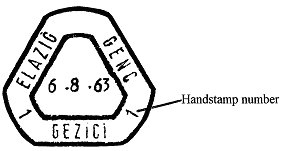
| |
| Type 5c - Gezici | |
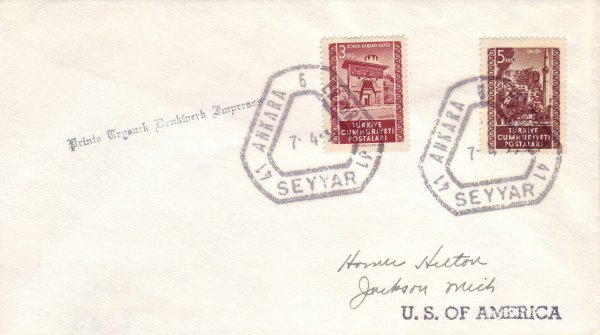
Ankara - Erzurum Seyyar, route number 41, distance 708 miles. A rare example of type 5b
The last style of handstamp is identical to the previous style, however, with the handstamp number shown upright in the bottom corners. As before, all lettering is upright and the route number if used is in the top corner.
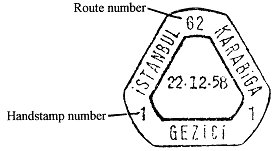
 |
|
| Type 6a - Gezici | Type 6b - Gezici - no Route number |
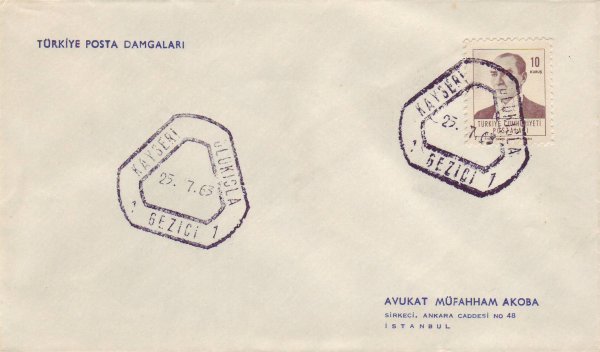
Kayseri - Ulukisla Gezici, no route number allocated, distance 142 miles
 From late 1972 the triangular handstamps were replaced by single circle rings introduced in the early 1970s
and continued in use on the last eleven Gezici until their demise in the 1990s. [Type 7].
From late 1972 the triangular handstamps were replaced by single circle rings introduced in the early 1970s
and continued in use on the last eleven Gezici until their demise in the 1990s. [Type 7].

Basmane (Izmir) - Afyon Gezici, posted at 14.00 hours, distance 261 miles.
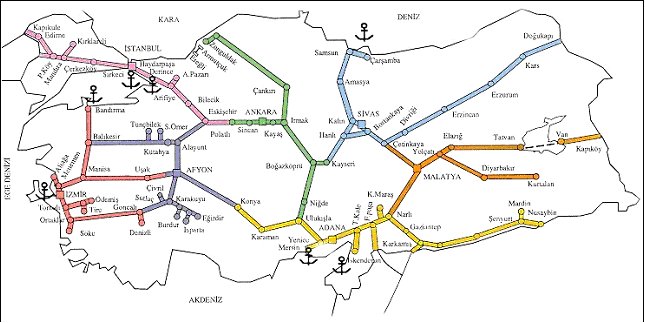
Map of main Turkish railways c2003
Source: collection of Robin Stubbs.

